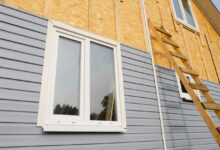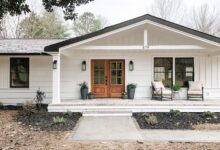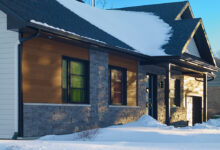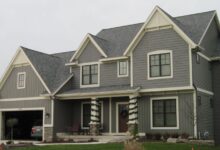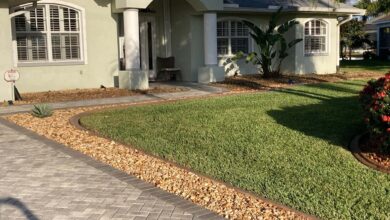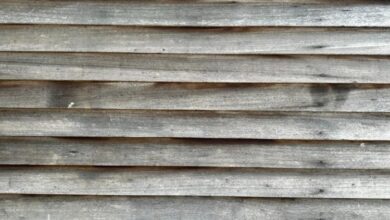Eco-Friendly Siding: Sustainable Home Choices
Eco-Friendly Siding: Sustainable Choices for Your Home. Building a sustainable future starts with conscious choices, and few decisions impact our environment as much as the materials we use to construct our homes. Traditional siding options often carry a significant environmental footprint, but thankfully, a wave of eco-conscious alternatives is transforming the building industry. This exploration delves into the world of eco-friendly siding, examining various sustainable materials, their installation, cost-effectiveness, aesthetic appeal, and the crucial role of certifications in ensuring genuine environmental responsibility.
We will investigate the benefits of opting for sustainable materials over conventional options, comparing their durability, maintenance requirements, and overall environmental impact. We’ll also explore the design possibilities, showcasing how eco-friendly siding can enhance the aesthetic value of any home, seamlessly blending sustainability with style.
Introduction to Eco-Friendly Siding
The building industry is experiencing a significant shift towards sustainable practices, driven by growing environmental awareness and a desire for healthier living spaces. Consumers are increasingly seeking building materials with a lower environmental footprint, recognizing the long-term impact of their construction choices on the planet. This heightened awareness has fueled a surge in demand for eco-friendly alternatives across various building sectors, including siding.
Traditional siding options, such as vinyl and certain types of wood, often carry a substantial environmental burden. Vinyl siding, derived from petroleum, is a non-renewable resource and contributes to greenhouse gas emissions during its manufacturing process. Furthermore, its disposal presents significant challenges due to its non-biodegradability. While wood siding can be a renewable resource, the harvesting and processing of some wood types can lead to deforestation and habitat loss, particularly if unsustainable forestry practices are employed. The manufacturing and transportation of these materials also consume considerable energy, further adding to their carbon footprint. The use of chemical treatments to protect wood siding from rot and insects introduces additional environmental concerns.
Eco-friendly siding represents a sustainable alternative to traditional options. It encompasses a range of materials and manufacturing processes designed to minimize environmental impact throughout the product’s lifecycle – from sourcing raw materials to disposal. The benefits of choosing eco-friendly siding extend beyond environmental protection; it often contributes to improved indoor air quality, increased energy efficiency (leading to lower utility bills), and enhanced durability, resulting in lower long-term maintenance costs.
Environmental Impact of Traditional Siding Materials
The environmental impact of traditional siding materials is multifaceted. Vinyl siding, for example, is primarily composed of polyvinyl chloride (PVC), a plastic derived from petroleum. The extraction, processing, and manufacturing of PVC contribute significantly to greenhouse gas emissions, contributing to climate change. Additionally, the energy-intensive manufacturing process consumes large amounts of fossil fuels. The longevity of vinyl siding, while often seen as an advantage, also means a longer period before disposal, delaying the environmental impact until the end of its life cycle. Improper disposal can lead to PVC leaching harmful chemicals into the soil and water. In contrast, while wood siding can be sourced from sustainably managed forests, the transportation of lumber over long distances and the use of chemical preservatives can also generate significant carbon emissions. The production of treated lumber, using chemicals like chromated copper arsenate (CCA), presents additional environmental risks due to the toxicity of these compounds.
Characteristics of Eco-Friendly Siding Materials
Eco-friendly siding options prioritize the use of renewable, recycled, or rapidly renewable resources. Many eco-friendly siding materials are manufactured using processes that minimize energy consumption and waste generation. These materials often exhibit excellent durability and longevity, reducing the need for frequent replacements. Furthermore, they are designed for easy recycling or biodegradation at the end of their life cycle, minimizing their overall environmental footprint. Examples include siding made from recycled materials, bamboo, fiber cement, and sustainably harvested wood.
Examples of Eco-Friendly Siding Materials
Several materials offer sustainable alternatives to traditional siding. Bamboo siding, for instance, is a rapidly renewable resource that requires minimal processing and produces less waste than other materials. Fiber cement siding, composed of cement, cellulose fibers, and other additives, is durable, fire-resistant, and requires less maintenance. Recycled plastic siding provides a sustainable use for plastic waste, diverting it from landfills. Furthermore, sustainably harvested wood, certified by organizations like the Forest Stewardship Council (FSC), ensures that the wood comes from responsibly managed forests. The selection of eco-friendly siding should consider factors such as climate, local regulations, and personal preferences.
Types of Eco-Friendly Siding Materials
Choosing eco-friendly siding offers a multitude of benefits, from reducing your environmental footprint to enhancing your home’s curb appeal. Several sustainable materials are available, each with unique characteristics impacting durability, cost, and environmental impact. Understanding these differences is crucial for making an informed decision that aligns with your budget and sustainability goals.
Comparison of Eco-Friendly Siding Materials
The following table provides a comparative overview of popular eco-friendly siding options. Remember that actual costs and durability can vary based on factors like installation, geographic location, and specific product quality.
| Material | Durability | Cost (Relative) | Environmental Impact |
|---|---|---|---|
| Recycled Plastic | High; resistant to rot, insects, and moisture. Can withstand harsh weather conditions. | Medium to High | Low; reduces landfill waste and uses recycled materials. Manufacturing process can have some environmental impact depending on energy sources used. |
| Reclaimed Wood | High; durable and long-lasting if properly maintained. Can develop a beautiful patina over time. | High | Low; reduces deforestation and utilizes existing resources. However, transportation and processing can still have an environmental footprint. |
| Fiber Cement | High; fire-resistant, durable, and low maintenance. Can be susceptible to cracking if not properly installed. | Medium to High | Medium; manufacturing requires energy, but the material is long-lasting and requires less frequent replacement than other options. |
| Bamboo | Medium; naturally resistant to pests and moisture, but can be susceptible to damage from extreme weather conditions without proper treatment. | Low to Medium | Low; rapidly renewable resource, requires minimal processing. However, transportation and potential use of chemical treatments can impact its overall environmental profile. |
Sourcing and Manufacturing Processes
The sustainability of eco-friendly siding extends beyond the final product to encompass its sourcing and manufacturing. Recycled plastic siding utilizes post-consumer plastics, diverting waste from landfills. Reclaimed wood is sourced from demolished structures or salvaged lumber, reducing the demand for newly harvested timber. Fiber cement combines Portland cement, cellulose fibers, and other additives, offering a durable and relatively low-impact material. Bamboo siding is harvested from sustainably managed forests, promoting responsible forestry practices. The manufacturing processes for each material vary, but generally aim to minimize energy consumption and waste generation.
Lifespan and Maintenance
The lifespan and maintenance requirements of each siding type differ significantly. Recycled plastic siding boasts a long lifespan, often exceeding 50 years with minimal maintenance, requiring only occasional cleaning. Reclaimed wood, while durable, may require periodic staining or sealing to protect against weathering. Fiber cement siding is also very durable, with a lifespan of 50 years or more, and needs minimal maintenance. Bamboo siding, while naturally resistant, might require more frequent maintenance, including occasional cleaning and potential re-treatment depending on the climate and exposure. Proper installation is crucial for maximizing the lifespan and minimizing maintenance for all siding types.
Installation and Application of Eco-Friendly Siding
Installing eco-friendly siding offers a sustainable way to enhance your home’s curb appeal and energy efficiency. Proper installation is crucial for maximizing the lifespan and performance of the chosen material, ensuring a worthwhile investment. This section details the process for recycled plastic siding, a popular and durable eco-friendly option, and compares it to another common choice: fiber cement.
Recycled Plastic Siding Installation: A Step-by-Step Guide
Recycled plastic siding, often made from post-consumer plastics, offers excellent durability and low maintenance. Its installation is relatively straightforward, similar to vinyl siding but with considerations for its unique properties.
- Preparation: Begin by thoroughly cleaning the existing wall surface, removing any loose paint, debris, or old siding. Ensure the underlying structure is sound and level. Visualize the siding layout, considering overlaps and cuts needed for corners and windows. This step is critical for a professional and long-lasting result.
- Starter Strip Installation: A starter strip, a specially designed piece of siding, is attached horizontally along the bottom of the wall. This provides a consistent starting point for subsequent siding panels and ensures a neat, aligned finish. The starter strip is typically secured using nails or screws, ensuring they are properly spaced and driven to avoid damage.
- Siding Panel Installation: The siding panels are then installed vertically, overlapping the starter strip. Each panel should be carefully aligned and secured using nails or screws specifically designed for the material. Proper spacing between fasteners is essential to allow for thermal expansion and contraction. Imagine aligning the panels like building with bricks, ensuring a seamless and uniform look.
- Corner and J-Channel Installation: Corner pieces and J-channels are used to finish off corners and around windows and doors. These pieces are designed to create a clean, weather-tight seal. Precise measurements and careful installation are essential for a visually appealing and water-resistant finish. Visualize a smooth transition around the house’s edges and openings.
- Finishing: Once all panels are installed, inspect the entire surface for any gaps or inconsistencies. Caulk any gaps to ensure a watertight seal. A final visual inspection is crucial for a quality finish.
Best Practices for Ensuring Proper Installation
Proper installation is key to maximizing the longevity and efficiency of your eco-friendly siding. This includes using appropriate fasteners, ensuring proper ventilation behind the siding, and following manufacturer’s instructions meticulously. Careful attention to detail during installation will prevent issues such as water damage, warping, and premature failure. For instance, using corrosion-resistant fasteners will protect the siding from premature damage in harsh weather conditions.
Comparison of Installation Methods: Recycled Plastic vs. Fiber Cement Siding
While both recycled plastic and fiber cement siding offer eco-friendly alternatives to traditional materials, their installation methods differ slightly. Recycled plastic siding, as described above, is typically installed using a similar method to vinyl siding, employing overlapping panels and specialized fasteners. Fiber cement siding, on the other hand, is often heavier and requires more robust fastening, potentially needing specialized tools and more experience. Fiber cement boards are larger, requiring fewer pieces but demanding more precise cutting and fitting. The increased weight necessitates stronger support structures and more careful handling to avoid breakage. Both require careful attention to detail, but fiber cement demands more precision and potentially more professional expertise.
Cost and Life Cycle Assessment
Choosing eco-friendly siding involves a careful consideration of both upfront and long-term costs, as well as the environmental impact across the product’s entire lifespan. While initial investment might be higher for some sustainable options, the potential for reduced maintenance, longer lifespan, and lower environmental impact can lead to significant long-term savings and benefits. This section will analyze the cost-effectiveness of various eco-friendly siding materials and explore their life cycle assessments.
Comparative Cost Analysis of Eco-Friendly Siding
This analysis compares the initial cost, maintenance requirements, and lifespan of three common eco-friendly siding materials: recycled plastic lumber, fiber cement, and sustainably harvested wood. The actual costs will vary depending on factors such as location, labor costs, and specific product choices. However, a general comparison can illustrate the relative cost differences. For example, recycled plastic lumber typically has a higher initial cost than pressure-treated wood but requires significantly less maintenance. Fiber cement offers a moderate initial cost and relatively low maintenance, while sustainably harvested wood presents a lower initial cost but may require more frequent maintenance and repainting. The following table provides a simplified comparison, assuming a 1000 sq ft home:
| Siding Material | Initial Cost (Estimate) | Annual Maintenance Cost (Estimate) | Lifespan (Years) |
|---|---|---|---|
| Recycled Plastic Lumber | $15,000 – $20,000 | $100 – $200 | 50+ |
| Fiber Cement | $10,000 – $15,000 | $200 – $500 | 30-50 |
| Sustainably Harvested Wood | $8,000 – $12,000 | $500 – $1000 | 20-30 |
Note: These are estimates and actual costs may vary significantly based on numerous factors.
Return on Investment (ROI) Calculation for Eco-Friendly Siding
Calculating the ROI for eco-friendly siding involves comparing the total cost of ownership (including initial cost, maintenance, and replacement) over the lifespan of the siding with that of a traditional option, such as vinyl siding. The formula for ROI is:
ROI = (Total Return – Total Investment) / Total Investment
For example, let’s consider a scenario where eco-friendly fiber cement siding costs $12,000 initially, requires $300 annual maintenance, and lasts 40 years. A comparable vinyl siding option might cost $8,000 initially, require $500 annual maintenance, and last 20 years. The total cost of ownership for the fiber cement siding would be approximately $24,000 ($12,000 + ($300/year * 40 years)), while the vinyl siding would cost approximately $18,000 ($8,000 + ($500/year * 20 years)). In this simplified example, the higher initial cost of the fiber cement siding is offset by its longer lifespan and lower maintenance, resulting in a potentially better long-term ROI. A more detailed analysis would consider factors like potential resale value increases associated with eco-friendly features.
Life Cycle Assessment of Recycled Plastic Lumber Siding
A life cycle assessment (LCA) evaluates the environmental impacts of a product across its entire lifespan, from raw material extraction to disposal. For recycled plastic lumber siding, this includes the energy consumption associated with plastic recycling, manufacturing, transportation, installation, and eventual disposal or recycling. While the manufacturing process does require energy, the use of recycled materials significantly reduces the demand for virgin resources and associated environmental impacts like deforestation and greenhouse gas emissions from petroleum extraction. Furthermore, the long lifespan of recycled plastic lumber reduces the frequency of replacement and associated waste generation. The overall environmental impact is highly dependent on the specific manufacturing process and the sourcing of the recycled plastic. LCA studies are available that quantify these impacts, demonstrating the potential for significant environmental benefits compared to traditional siding materials. For instance, a study comparing recycled plastic lumber to vinyl siding might show that recycled plastic lumber has a smaller carbon footprint due to the use of recycled materials and its longer lifespan.
Aesthetic Considerations and Design
Eco-friendly siding offers a wide array of aesthetic possibilities, allowing homeowners to enhance their property’s curb appeal while minimizing environmental impact. The visual appeal of sustainable materials is often enhanced by their natural textures and colors, providing a unique and sophisticated look compared to traditional siding options. Careful consideration of color, texture, and design can ensure that eco-friendly siding not only protects your home but also significantly improves its overall aesthetic value.
The successful integration of eco-friendly siding into architectural designs hinges on understanding how different materials complement various home styles. A thoughtfully chosen siding material can elevate a home’s architectural character, adding depth, texture, and visual interest. For instance, the rustic charm of reclaimed wood siding can beautifully complement a farmhouse or cabin-style home, while the sleek, modern lines of fiber cement siding are ideal for contemporary architecture.
Examples of Architectural Designs Incorporating Eco-Friendly Siding
Reclaimed wood siding, with its varied tones and textures, creates a visually rich façade on a rustic farmhouse. Imagine a two-story home with wide, overhanging eaves, large windows, and a wraparound porch. The reclaimed wood siding, exhibiting a mix of light and dark browns, grays, and even hints of reddish hues, contributes to a warm, inviting, and naturally aged appearance. The uneven texture of the wood adds visual depth and character, creating a sense of history and craftsmanship. In contrast, a modern home with clean lines and minimalist design could feature fiber cement siding in a sophisticated gray or charcoal color. The smooth, even surface of the fiber cement provides a sharp contrast to the home’s geometric forms, enhancing its contemporary aesthetic. Large, expansive windows would further showcase the clean lines and the siding’s subtle color.
Color and Texture Choices for Different Home Styles
A Craftsman-style home, characterized by its low-pitched roof, exposed rafters, and handcrafted details, could be beautifully complemented by cedar shake siding in a natural, earthy tone. The texture of the cedar shakes adds visual interest and complements the home’s handcrafted elements. The natural variations in color create a warm, inviting atmosphere. Conversely, a Victorian-style home, with its ornate detailing and asymmetrical façade, might benefit from fiber cement siding painted in a rich, deep color such as burgundy or forest green. This would highlight the architectural details while providing a durable and low-maintenance exterior. The smooth surface of the fiber cement would allow the intricate details of the home’s architecture to stand out.
Design Tips for Maximizing Aesthetic Appeal While Maintaining Sustainability
Prioritizing locally sourced materials reduces transportation costs and emissions, minimizing the environmental impact. Using reclaimed wood, for example, not only provides a unique aesthetic but also diverts waste from landfills. Careful planning and precise installation are crucial for ensuring a seamless and visually appealing finish. Professional installation ensures proper alignment and minimizes waste, further enhancing the aesthetic outcome and maximizing the lifespan of the siding. Selecting colors and textures that complement the surrounding landscape and the home’s architectural style creates a harmonious and visually pleasing effect. For example, choosing earth tones that blend seamlessly with the natural environment can create a sense of unity between the home and its surroundings. Furthermore, incorporating green roofing techniques alongside eco-friendly siding creates a cohesive and environmentally conscious design.
Resources and Certifications
Choosing eco-friendly siding involves careful consideration of material sourcing, manufacturing processes, and long-term environmental impact. Verifying the sustainability claims made by manufacturers is crucial for informed decision-making. This section outlines resources and certifications to assist in this process.
Reputable organizations provide certifications and standards for eco-friendly building materials, offering a level of assurance regarding the environmental claims made by manufacturers. Access to reliable information on sustainable siding suppliers and installers is also vital for successful project implementation. These resources help ensure that the chosen siding truly aligns with sustainable building practices.
Reputable Organizations for Eco-Friendly Building Material Certification
Several organizations offer certifications for sustainable building materials, providing independent verification of environmental claims. These certifications often cover various aspects, including material sourcing, manufacturing processes, and end-of-life management. Choosing materials with these certifications increases confidence in their eco-friendly attributes.
- LEED (Leadership in Energy and Environmental Design): Developed by the U.S. Green Building Council, LEED certification assesses building projects based on various sustainability criteria, including material selection. LEED-certified products often meet stringent environmental standards.
- Forest Stewardship Council (FSC): The FSC certifies forests managed according to environmentally sound, socially beneficial, and economically viable principles. Siding materials made from FSC-certified wood demonstrate responsible forestry practices.
- GreenGuard: GreenGuard certification verifies that products meet stringent indoor air quality standards. This is particularly important for siding materials, as they can release volatile organic compounds (VOCs) that impact indoor air quality.
- Cradle to Cradle Certified™: This certification assesses products based on their material health, material reutilization, renewable energy use, water stewardship, social fairness, and carbon management. Products receiving this certification demonstrate a commitment to circular economy principles.
Resources for Finding Eco-Friendly Siding Suppliers and Installers
Locating suppliers and installers specializing in eco-friendly siding can be facilitated through various online and offline resources. These resources help connect homeowners with businesses committed to sustainable building practices.
- Online Directories: Numerous online directories specialize in green building products and services. These directories often allow users to search for suppliers and installers based on location and specific material types. Examples include websites dedicated to sustainable building practices and those focusing on specific eco-friendly materials.
- Local Green Building Councils: Local Green Building Councils often maintain lists of certified professionals and businesses involved in sustainable construction. These councils can provide valuable recommendations and guidance.
- Professional Associations: Professional associations for builders and contractors frequently include members who specialize in eco-friendly construction techniques. These associations can be a valuable resource for identifying reputable professionals.
- Manufacturer Websites: Many manufacturers of eco-friendly siding provide lists of authorized installers or distributors on their websites. This is a direct way to connect with businesses handling their specific products.
Importance of Certifications and Labels
Certifications and labels provide independent verification of the sustainability claims made by siding manufacturers. They help consumers make informed decisions by offering assurance regarding the environmental impact of the chosen materials. Relying solely on manufacturer claims without independent verification can be risky.
Choosing siding with recognized certifications minimizes the risk of “greenwashing,” where environmental claims are exaggerated or unsubstantiated.
Last Point
Choosing eco-friendly siding isn’t merely a trend; it’s a commitment to a healthier planet and a more responsible future. By understanding the various options available—from recycled plastic and reclaimed wood to fiber cement and bamboo—homeowners can make informed decisions that align with their values and contribute to a more sustainable built environment. The initial investment in eco-friendly siding often translates into long-term cost savings and a reduced environmental impact, making it a truly worthwhile investment for both the homeowner and the planet. Embrace the possibilities and build a home that reflects your commitment to sustainability.

